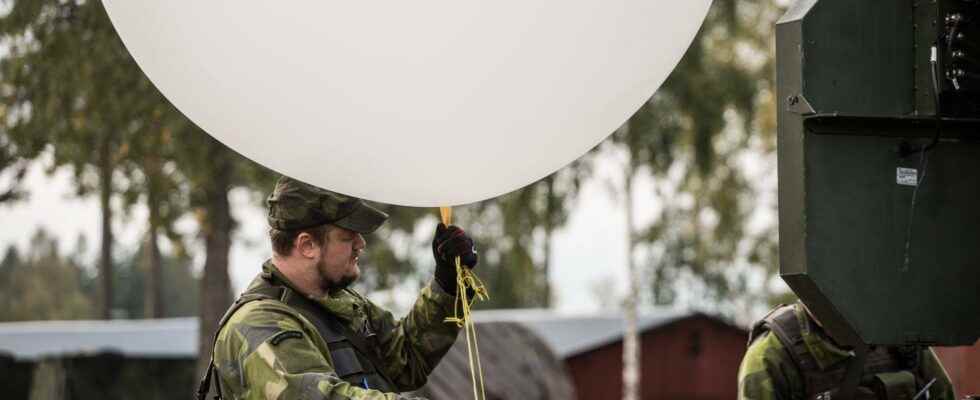Published: Just now
1 of 3 Photo: The Armed Forces/TT
In a short time, the balloon has become the subject of espionage accusations and frosty relations between the world’s major powers.
In Sweden, balloons, twice the size of the Globe, are sent up from the Esrange space base, and smaller balloons are often used by SMHI and the Swedish Armed Forces – although for completely different purposes than espionage.
The suspected Chinese spy balloon that was shot down by US warplanes barely two weeks ago is still being investigated. According to China, it is a weather balloon intended for research that ended up adrift. The US, for its part, has accused China of using a global fleet of balloons to spy on countries around the world.
On Swedish soil, balloons are not unusual. However, not for surveillance and espionage, according to Hans Liwång, docent in defense systems at the University of Defense.
– We very rarely do that type of acquisition because we are interested in defending our own territory, he says.
Inside the borders, the Swedish Armed Forces have sufficient control with the help of other resources, says Hans Liwång.
– We have no need to supplement military aircraft in Swedish airspace with balloons, which are able to fly.
However, they are not completely useless. In artillery, balloons are very useful for finding out temperature, humidity and wind direction.
– This way you can correct the artillery fire. It only takes a few minutes and then the balloons are used up, they have no intelligence in them, says Hans Liwång.
Weather balloons become UFOs
Similarly, SMHI uses weather balloons. Filled with helium and no larger than a meter in diameter, transmitters are sent up and are still an important tool for calculating what the weather will be like in the coming days.
Over the years, the weather balloons have often been the explanation when UFO sightings have been made in places around the world.
– It’s a little different how high it gets, but normally it’s about 25 kilometers high. Then the balloon has become so big that it bursts, says Pia Bladh, responsible for SMHI’s auto broadcasting stations.
From SMHI’s stations in Sundsvall and Landvetter, daily broadcasts are made, and information is also shared from stations in Luleå and Visby, which are managed by the Swedish Armed Forces.
The weather station is usually not up for more than two hours, although there have been exceptions.
– I imagine that someone who was released from Sundsvall was found on Åland. But it’s not a question of it ending up in the middle of Russia or something like that, it doesn’t have time to get that far, says Pia Bladh.
Giant balloons for space research
The balloons are also invaluable for research purposes. In the last decade, Sweden has sent up several giant balloons to study, among other things, black holes and neutron stars.
From the Esrange space base outside Kiruna, the first successful launch was made in 2013. To carry an X-ray telescope weighing two tons, a helium balloon of over one million cubic meters was required – the size of two Globes.
– You can mount the telescope on a satellite and send it out with a launch vehicle, but it is very expensive. Furthermore, if you develop a new telescope like we are doing, you don’t dare to do it until you have tested a prototype, and that’s when the balloon comes in, says Mark Pearce, professor of astroparticle physics at KTH who led the so-called PoGo projects.
Visible from the ground
The huge balloon can only be released sometime between the middle of May and the end of July. Then the conditions in the stratosphere are optimal for a flight: constant westerly wind circularly around the North Pole.
– Before flying, you must ask for permission from all the countries concerned to fly over their airspace. There is a lot of documentation you have to collect before you get permission to take off from the ground, says Mark Pearce.
Thanks to the sun, the balloon, despite an altitude of 40 kilometers, is visible to the human eye as a dot of light in the sky. Once in the air, the balloon can only be adjusted in height with the help of ballast and valves. Before a flight, careful forecasts of the wind conditions are therefore made.
– Usually you are very good at pinpointing where the equipment lands, says Mark Pearce.
– We were a bit unlucky in 2013. We released the balloon a bit late due to the wind conditions and we had to land in Russia which created some practical problems, but it went great. We had good cooperation with Russia at that time.
Facts
Swedish research balloons
Suspended under a helium balloon with a volume of 1.1 million cubic meters, twice the size of the Globe in Stockholm, the instrument Pogo has completed several flights from Esrange in Kiruna.
The projects were developed between research groups in Sweden, Japan and the USA and aimed, among other things, to study the Crab Nebula, a remnant of a supernova that exploded in 1054.
The balloon does not go into orbit, but flies at the top of the Earth’s atmosphere at an altitude of 40,000 meters.
In 2013, the balloon traveled in a circle around the Earth’s North Pole over Norway, past Iceland, Greenland and Canada before landing in northern Russia after 14 days.
In 2016, an updated version of the telescope flew from Esrange in Kiruna to Victoria Island in northern Canada.
In July 2022, a new telescope, XL-Calubur, was sent up as a continuation of the previous projects. The telescope is 12 meters long and weighs around two tonnes. The flight also ended there over Victoria Island in Canada.
Source: The Swedish Space Agency and KTH
Read more
